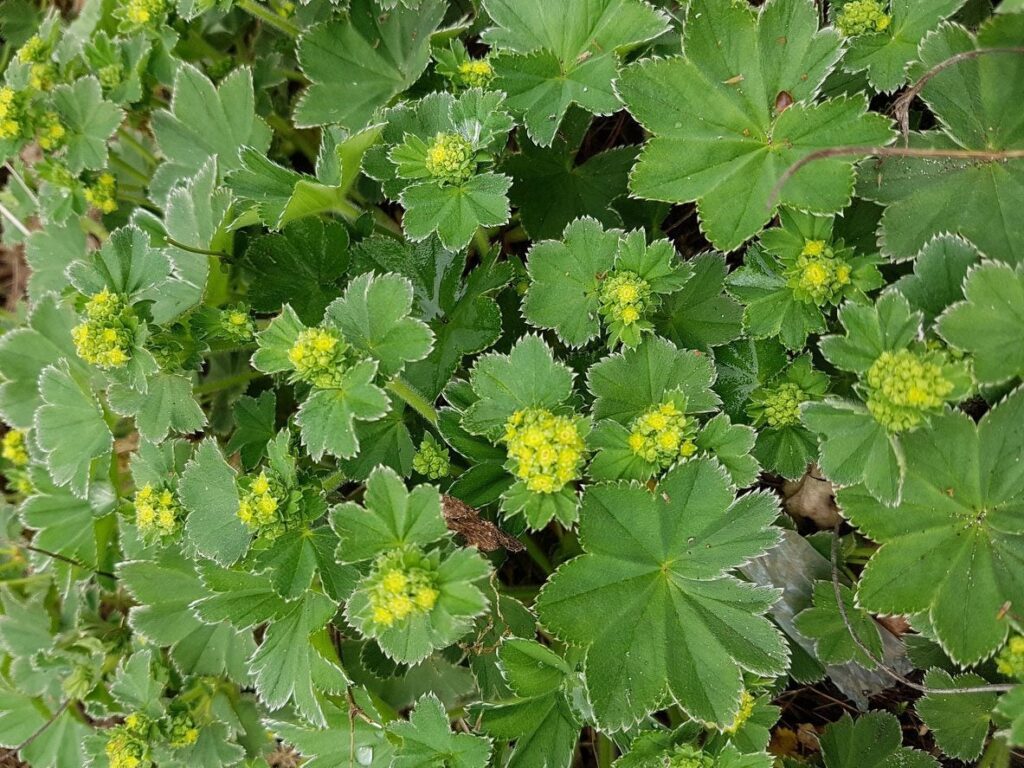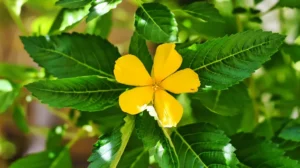Lady's Mantle

Lady’s Mantle is a perennial herb known for its fan-shaped, serrated leaves and small yellow-green flowers. It has been traditionally used in herbal medicine for centuries, particularly in treating women’s health issues. The herb is also admired for its beauty in gardens and has spiritual significance in various cultures.
Size:
- Lady’s Mantle typically grows to a height of 12 to 24 inches (30 to 60 cm), making it a low-growing herb.
- The plant spreads about 12 to 24 inches (30 to 60 cm) in width, forming a neat, rounded clump.
Color:
- The leaves are a soft green color with a slightly silvery sheen, especially when wet with morning dew.
- The flowers are a subtle yellow-green, forming clusters that contrast nicely with the foliage.
Texture:
- The leaves have a velvety texture, often holding water droplets like small pearls after rain, which adds to their visual appeal.
- The flowers are delicate and slightly fuzzy, giving them a soft appearance.
Fragrance:
- Lady’s Mantle has a mild, earthy fragrance, which is not overpowering but adds to its gentle and soothing nature.
Uses:
- Lady’s Mantle is traditionally used to regulate menstrual cycles, alleviate menstrual cramps, and ease symptoms of menopause. It is often found in teas and tinctures designed for women’s health.
- The astringent properties of Lady’s Mantle make it useful for treating minor cuts and abrasions. It can be applied as a poultice or in a salve.
- Due to its attractive foliage and flowers, Lady’s Mantle is popular in garden borders and as ground cover. Its ability to hold dew droplets makes it a favorite in early morning gardens.
Habitat:
- Lady’s Mantle thrives in cool, moist environments, often found in meadows, woodland edges, and along stream banks in Europe and Asia.
- It prefers partial shade but can tolerate full sun in cooler climates. It requires well-drained, fertile soil to grow well.
Cultural Significance:
- Historically, Lady’s Mantle has been associated with protection, particularly for women and children. It was believed to guard against evil spirits and was often planted near homes for this purpose.
- The plant’s Latin name, Alchemilla, is derived from the word “alchemy,” as the dew collected from its leaves was believed to have magical properties and was used in alchemical practices.
Spiritual Properties
- Feminine Power: Lady’s Mantle is closely associated with feminine energy, symbolizing the nurturing and protective aspects of womanhood. It is often used in rituals and ceremonies to honor female deities and to invoke feminine strength.
- Healing and Protection: The herb is considered protective, especially for women and children. It is believed to offer spiritual protection, guarding against negative energies and harm.
- Connection to Nature: Lady’s Mantle is revered for its connection to the earth and water. It is used in rituals to strengthen one’s bond with nature and to harness the healing powers of the earth.
Medicinal Properties
- Menstrual Health: Lady’s Mantle is widely used to alleviate menstrual cramps, regulate cycles, and manage heavy bleeding. Its astringent properties help tone the uterus and reduce menstrual discomfort.
- Menopause Relief: The herb is also helpful in easing symptoms of menopause, such as hot flashes and mood swings, by balancing hormones naturally.
- Digestive Aid: Lady’s Mantle can be used to soothe digestive issues, including diarrhea and gastritis, due to its anti-inflammatory and astringent properties.
- Wound Healing: Its astringent and anti-inflammatory qualities make Lady’s Mantle effective in treating minor wounds, cuts, and skin irritations.
Adverse Actions & Side Effects
- Allergic Reactions: Some individuals may experience allergic reactions when using Lady’s Mantle, such as skin irritation or itching. It is advisable to perform a patch test before using it topically.
- Hormonal Effects: Due to its effects on hormones, Lady’s Mantle should be used cautiously by individuals with hormone-sensitive conditions or those on hormone therapy.
Side Effects
- Gastrointestinal Discomfort: In rare cases, Lady’s Mantle may cause mild gastrointestinal discomfort, such as nausea or bloating, especially when consumed in large quantities.
- Blood Clotting: The herb has astringent properties that may increase the risk of blood clotting. Individuals on blood-thinning medications should consult a healthcare provider before using Lady’s Mantle.
- Photosensitivity: Lady’s Mantle may increase sensitivity to sunlight, leading to a higher risk of sunburn. It is recommended to use sun protection when spending time outdoors.

Jiaogulan
Jiaogulan Jiaogulan, often referred to as "Southern Ginseng" or "Herb of Immortality," is a climbing vine native to Southern China and other parts of Asia.

Rama Holy Basil
Rama Holy Basil Rama Holy Basil is a revered herb in Ayurveda and has a significant presence in traditional Indian medicine. Known for its aromatic

Menthol Crystals
Menthol Crystals Menthol Crystals are derived from peppermint oil and are known for their strong, cooling sensation and refreshing fragrance. These crystals are used in

Damiana Leaf
Damiana Leaf Damiana Leaf is an aromatic herb known for its use in traditional medicine, particularly in Central and South America. It is valued for

Papaya Leaf
Papaya Leaf Papaya Leaf (Carica papaya) comes from the tropical fruit tree known for its large, deeply lobed leaves. While the fruit of the papaya

Hops Flowers
Hops Flowers Hops flowers are known for their distinctive appearance, fragrance, and various applications, particularly in brewing and herbal medicine. The cone-shaped flowers, harvested from